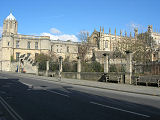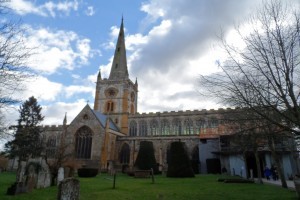Tour and Explore Cathedrals and Churches
Research suggests that although our splendid collection of religious buildings are not seen as a deciding factor when choosing a break, they have an important impact on our visitor's experience - for example they are fascinating to visit, to admire the splendid architecture, the stained glass windows, the monuments and connections with famous people as well as to enjoy the peace, the quiet and spirituality of the building. Here are some of the many to be seen....
Gloucester Cathedral
|
Is probably one of the finest Cathedrals in England. Originally it was the Abbey Church of a Benedictine Monastery. It became a Cathedral in 16th century after Henry VIII destroyed the monastic buildings, saving the church because it held the remains of some of his ancestors. King Edward II is buried near the high altar after being murdered at nearby Berkeley Castle. With the enormous number of pilgrims visiting Edward II's tomb, the money donated enabled Edward III to rebuild the east end in the latest perpendicular style. The East Window is one of the largest medieval windows in the country and contains much of its original stained glass. The 15th century cloisters have some magnificent fan vaulting. |
 |
Bath Abbey
|
Since 757 AD, there have been three different churches on the site of Bath Abbey. The present Abbey Church was founded in 1499 when the newly appointed, Bishop of Bath, Oliver King, is said to have been shocked to find the church in ruins. He had a dream telling him to build a new church. The story of the dream is carved in stone on the front of the Abbey. |
 |
Fairford Church
|
Cotswold Wool Merchant John Thame began rebuilding Fairford church in the early 1490's. It was completed by his son Edmund and is therefore considered among the number of "wool churches" in the region. Fairford Church is internationally famous for its complete set of medieval windows which gives a visual account of the Bible stories from Adam and Eve through to the Last Judgement
|
 |
Worcester Cathedral
|
The Cathedral lies alongside the River Severn and is a great landmark in the city. It contains the royal tomb of King John and the tomb of Prince Arthur, surrounded by a magnificent chantry chapel. There are medieval cloisters, an ancient crypt and chapter house. Composer Edward Elgar is remembered with a stained glass window and memorial plaques in the west end.
|
 |
Oxford Cathedral
|
Was founded by Cardinal Thomas Wolsey on the site of St Freideswide's Abbey. It is also the chapel to Christchurch University College. Charles Dodgson was an Oxford Mathematics Don who befriended Dean Liddell's daughters and took them on outings, telling them stories as they punted along the river. Alice persuaded him to write the stories down and they are the Stories of Alice in Wonderland under the pen-name of Lewis Carroll. Tom tower, which you can see in the picture was built by Sir Christopher Wren.
|

|
All Saints Church, Brockhampton
|
This is one of a very few thatched churches in the country. The architect was William Lethaby, a leading light in the Arts and Crafts Movement. Local craftsmen were employed to build it and
it contains tapestries by Edward Burne Jones which were made in the workshops of Morris and Co
|

|
Tewkesbury Abbey
|
In the centre of Tewkesbury is the superb abbey church of St Mary the Virgin with its impressive Norman tower, one of the largest in the world, and largest exterior arch in the world as seen in the photograph alongside. The church dates back to the early 1100's, and is known for its marvellous collection of ornate medieval chantry chapels.
|

|
Holy Trinity Church, Stratford-Upon-Avon
|
This lovely church is situated on the banks of the River Avon. It was where William Shakespeare was baptised and is where he and some of his family are buried. We can enjoy the calm ambience of this lovely building and also visit Shakespeare's grave in the chancel, where we will see the inscribed curse on his tombstone "Good friend for Jesus sake forbear; To dig the dust enclosed here! Blest be the man that spares these stones, And curst be he that moves my bones".
|

| |








